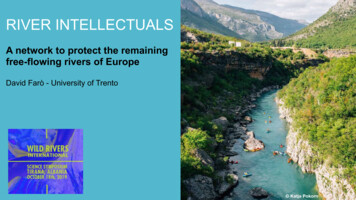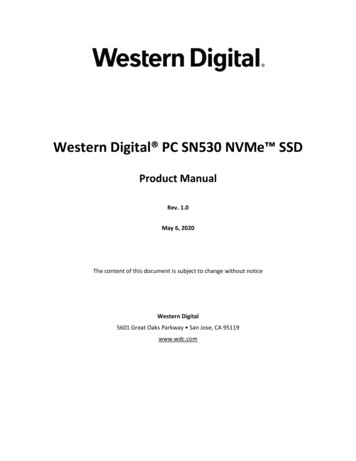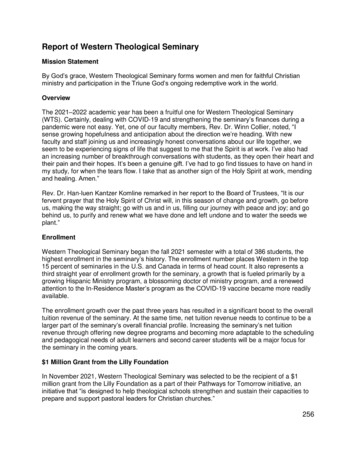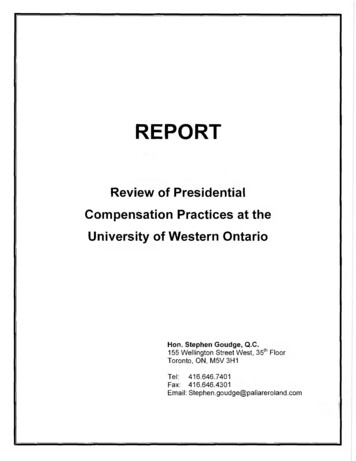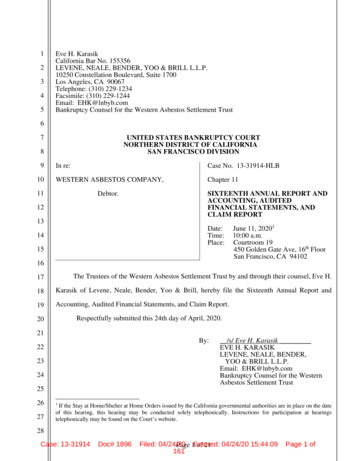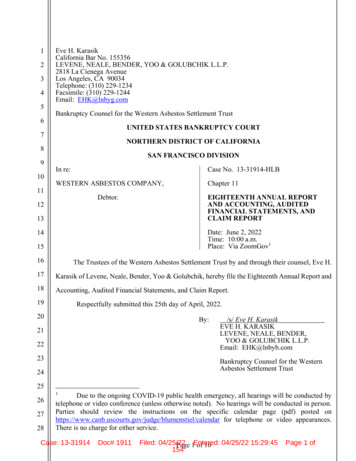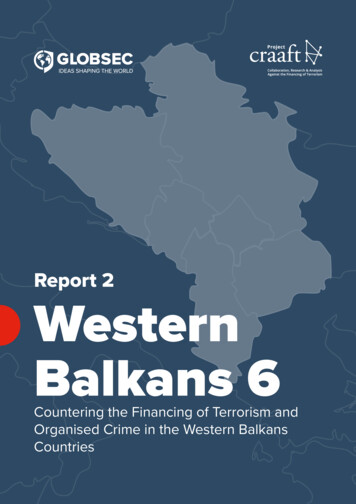
Transcription
Report 2WesternBalkans 6Countering the Financing of Terrorism andOrganised Crime in the Western BalkansCountries
2 ) Western Balkans 6 Countering the Financing of Terrorism and Organised Crime in the Western Balkans CountriesExecutiveSummaryThe aim of this report is to present an overview ofFinancial Intelligence Units (FIU) in the six countries ofthe Western Balkans. On the national level, threats ofterrorism and the financing of terrorist organisations areexamined. The main focus is placed on the internationalcooperation of FIUs as well as on examining thevulnerability of not-for-profit organisations (NPO).While at the end of each country chapter there arerecommendations based on our research, this analysisalso contains a discussion on serious organised crimeand its links with terrorism. Succinctly, no direct linksbetween organised crime and terrorism were identified.The reasons for this are varied; however, the main findingof this analysis is that there are commonalities betweenthe FIUs, which has had a notable effect. Namely, countrymemberships in the Egmont Group have certainlyhelped the whole region to make progress in the areaof anti-money laundering and countering terroristfinancing (CTF). There are still problems pertaining tothe technology gap and human capacities, particularlyin working with NPOs as well as their awareness ofrisks are rising. However, the role of FIUs should bein proactive outreach in relation to NPOs. Our deskresearch confirmed an annual regional FIU conferencethat could be an example of best practice. The closingof remaining gaps would also enable the work of FIUs.
Countering the Financing of Terrorism and Organised Crime in the Western Balkans Countries Western Balkans 6 ( 3ContentsExecutive Summary.2Introduction.4Serious and Organised Crime .5Links to the Financing of Terrorism.6Financial Intelligence Units. 7Models of FIUs. 7West Balkan 6 Analyses.9Open Balkan Initiative.11North Macedonia.12Financing of Terrorism Risk. 12International Cooperation of the FIO.13NPOs in North Macedonia.13Country recommendations:. 15Kosovo.16Financing of Terrorism Risk.17NPOs in Kosovo.17International Cooperation. 18Country recommendations:. 19Montenegro. 23Terrorism Financing Risk. 23NPOs Sector in Montenegro. 24International Cooperation. 24Country Recommendations. 25Recommendations:. 25Albania. 26Terrorism Financing Risk. 26NPOs in Albania. 28International Cooperation. 29Recommendations. 29Bosnia and Herzegovina. 30Terrorism Financing Risk. 30NPOs in Bosnia and Herzegovina.31International cooperation.31Recommendations. 32Conclusion. 33Serbia. 20Financing of Terrorism Risk. 20NPOs in Serbia. 20International Cooperation. 22Country recommendations. 22This project was funded by theEuropean Union’s Internal SecurityFund – Police
4 ) Western Balkans 6 Countering the Financing of Terrorism and Organised Crime in the Western Balkans CountriesIntroductionThis report is part of a project funded by the EuropeanUnion’s International Security Fund-Police. The projectCRAAFT is a research and community building initiativedesigned to build stronger, more coordinated counterterrorist financing capacity across the EU and in itsneighbourhood. This particular research is focusing onthe capacities of Financial Intelligence Units –bodiesthat review suspicious transactions to combat terroristfinancing and money laundering. Via a series ofinterviews and desk analysis, GLOBSEC is conductingneeds analysis reports. While the first report wasfocused on the Visegrad Four (V4)1, this one will zoomin on the Western Balkans countries (WB6)2. After anintroductory overview of organised crime in the region,the main focus is dedicated to a country-by-countryreview of the organisation of FIUs and the internationalcooperation between FIUs themselves. An integralpart of this report is the analysis of the compliance ofnational AML / CFT systems with FATF Recommendations1 and 8, which addresses the risk assessment to theNPO sector for the purposes of terrorist financing3.The report’s findings will have been presented in theirdrafted form to the FIU representatives at a regionalworkshop for feedback before finalising the writing.Simultaneously, as part of the feedback process, adiscussion on common challenges and sharing ofexperiences between the two regions will take place. Thisalso serves as a tool for feeding data into the researchthat aims to map the needs of each region’s FIUs.1In alphabetical order: Czechia, Hungary, Poland, and Slovakia2In alphabetical order: Albania, Bosnia and Herzegovina, Kosovo, Montenegro, North Macedonia, and 02012.pdf
Countering the Financing of Terrorism and Organised Crime in the Western Balkans Countries Western Balkans 6 ( 5Serious and Organised CrimeOne of the main factors favouring the presence anddevelopment of serious and organised crime in the WB6is the region’s geographic position at the crossroadsbetween Europe and the Middle East. Moreover, they aresituated on the external borders of the Schengen zoneand are partly surrounded by EU member-states. Thetransnational aspect of organised crime in the region isvery developed: the Western Balkans is a centre for thetrafficking of many illicit commodities and a geographicalhub for the smuggling of migrants who are trying toenter Western Europe.4 According to David Binder,organised crime is not an exclusive Balkan speciality like,for instance, Shopska salad yet it is just as ubiquitous.In these times of widespread poverty, of physical andsocial ruin left by a series of civil wars and weak centralgovernments, criminal activities have risen to becomethe largest industry in the region. It is regulated notby traditional power structures, but by multi-ethnicnetworks of bosses, transporters, dealers and enforcers.The ingredients of this Western Balkan version aremobile phones, big trucks, vans, buses, fast cars andboats while the oil for mixing all these componentstogether is bribery. Organised crime depends onwilling partners in the police, customs, border guards,judiciary and, ultimately, the political class.5Other significant factors are a long process oftransition and socioeconomic recovery, and thelegacy of circumstances that prevailed during theconflicts in the territory of the former Yugoslavia,which resulted in the development of certaintypes of organised crime and reinforcement oftheir connections in the Western Balkans.Organised crime constantly develops new manifestationsand adjusts to new social conditions and circumstances.Certain types of organised crime are becomingincreasingly complex as a result of greater regional andinternational linking between and among organised crimegroups (OCGs), and they are becoming more and morecharacterised by a heterogeneous structure and a highlevel of flexibility.6According to the North Macedonianauthorities, modern information technologies andmeans of communication affect the maintenanceand creation of new interrelationships of members oforganised crime groups. New information technologies,social media, telephone internet applications forcommunication will continue to be the main means ofcommunication between organised crime groups, butalso one of the main ways to recruit new members oforganised crime groups. The use of social networksand other internet applications enables faster andmore secure contact between members of criminalgroups and thus adversely affects the provision ofevidence. OCGs use online platforms to trade goodsand services through the use of the darkweb.7The structures of the criminal groups often depend onthe prominent criminal activity in which they are engaged.Migrant smuggling groups are loosely connected withone boss or a simple hierarchy and sophisticated modesof cooperation between groups. Collaborators havespecific roles such as guides, drivers, accommodationproviders or money receivers. Drug trafficking groupsare more flexible and less hierarchical in structure,with clusters specialised in certain services (e.g.,wholesale, retail) and with limited links between them(generally via one contact person). Groups engagedin human trafficking are not cohesive networks, butchain-like, arranged with small clusters at both originand destination locations, the latter being the locationat which they engage in the exploitation of victims.8The production and smuggling of drugs in the WB6represent the most dominant and the most profitabletype of organised crime, in which the largest numberof OCGs are involved. As regards drug smuggling, theWB6 are transit countries. Certain quantities remainin their territories for the purpose of consumption orstorage, and marijuana and synthetic drugs are illegallyproduced for the needs of the local market. The drugmarket is dynamic as a result of the fact that most ofthe routes used by the OCGs are also used for thesmuggling of other types of products (excise goods,cigarettes, etc.). Western Balkans OCGs participatein the smuggling of cocaine from South America, andthis identified trend will continue to grow while themethods of smuggling will constantly change and involvesophisticated methods of concealment and the use ofmodern information technologies in communication.94Global Initiative Against Transnational Organised Crime, SPOT PRICES Analysing flows of people, drugs and money in the Western Balkans, May 2021,Available on: ans-crime-hotspots-3/.5David Binder spoke together with John F. Markey, Director of Law Enforcement Assistance Programs and Coordinator, SECI, U.S. Department of State,at an EES seminar titled “Combating Organised Crime in the Balkans” on January 22, 2002. The above is a summary of Mr Binder’s presentation.Meeting Report #269., Available on: ized-crime-the-balkans.6OSCE Mission in Serbia, REGIONAL SERIOUS AND ORGANISED CRIME THREAT ASSESSMENT Report, Developed within the project “EnhancingCapacities for Strategic Analysis and Strategic Assessment in the Criminal Investigation Directorates of the Serbian, Montenegrin and the formerYugoslav Republic of Macedonia Ministries of Interior”. The project is funded by the Government of Switzerland within the Regional Police CooperationProgram (2012-2016), and it is implemented by the OSCE Mission to Serbia. Available on: zed-crimethreat-assessment.7Ministry of Interior, Serious and Organised Crime Threat Assessment, Mid-term Review 2019, Ministry of Interior, 2019, p. 12.8UNITED NATIONS OFFICE ON DRUGS AND CRIME, MEASURING ORGANISED CRIME IN THE WESTERN BALKANS, 2020, Available on: E Mission in Serbia, REGIONAL SERIOUS AND ORGANISED CRIME THREAT ASSESSMENT rganized-crime-threat-assessment
6 ) Western Balkans 6 Countering the Financing of Terrorism and Organised Crime in the Western Balkans CountriesRegarding the Regional Serious and OrganisedCrime Threat Assessment (SOCTA) Report, illicitcannabis trafficking had been on the rise until theproduction in Albania was reduced, which resulted inan increase in prices as well as the number of illegallaboratories for the production of “natural” cannabisin traditional settings and modified canabis underartificial conditions.10 The other WB6 countries willremain the countries of transit for smugglers takingcannabis along the Balkan route to Central Europe.Firearms trafficking in the Western Balkans ismostly intra-regional, although the high price ofweapons in the markets outside of the regionalso triggers firearms trafficking from the WesternBalkans to other parts of Europe, Western Asiaand North America. Quite often organised criminalgroups traffic firearms within the region to enforcediscipline, intimidate rival groups or ensure theprotection of a group’s activities and members.11Links to the Financing of TerrorismDespite the loss of territory and fall of the so-called“Caliphate”(ISIS), the threat of terrorism is stillpresent and conditioned by changes in the formsand methods of terrorist activity. Namely, the idea ofsurvival of the Caliphate has been transformed froma territorial to a “Virtual Caliphate”, by inspiring andencouraging the execution of terrorist activities.The WB6 region has not remained immune to thephenomena of terrorism and violent extremism that ledto terrorist activities. The activities of extreme criminaland radical groups and individuals are documented inthe region, as well as persons who have taken an activepart in combat in crisis regions. At the moment, thebiggest threats to the WB6 countries are the returneesfrom the crisis hotspots as well as other radicalisedpersons who on their own initiative or under theinfluence or instructions of foreign terrorist fighters ormembers of terrorist organisations may be involved inthe planning or the logistics of terrorist activities in theregion. Terrorists infiltrating migrant routes transitingthrough WB6 countries also pose a potential threatbecause of the possibility of establishing connectionswith individuals in the region who could use them to carryout terrorist activities or get involved with said logistics.Given the above-mentioned threats, WB6 investigatorshave shown an understanding of these threats andthrough individual and joint efforts, several terroristattacks have been identified and prevented in a timelymanner. For example, the planned terrorist attack at theAlbania-Israel football match could only be detectedand prevented with the cooperation of counterpartauthorities in Kosovo and North Macedonia (in this case,the organisers were arrested in Kosovo and thus thefinancing aspects are mainly investigated there).12Inanother case, аs part of several consecutive actionsby North Macedonian police, 11 members of a terroristorganisation were suppressed and a large number ofweapons, ammunition and explosives were seized as partof this particular case. The organiser of this group createda terrorist-criminal organisation in which 10 other peoplewere members, forming a terrorist-criminal organisation– in other words, a “cell” – which was based on theideological foundations of the terrorist organisation ISIS.13Overall, the rating for the WB6 region in the context ofthe risks and threats of terrorist financing ranges fromlow to medium. As part of investigations and nationalassessments, authorities found no links betweenorganised crime groups operating in the region andthose linked to terrorism. Based on the knowledge thatterrorism is financed from legal and illegal sources, in theWB6 countries, several observations and assessmentsof the threat of terrorist financing have been made,and according to the prophylaxis of the manifestationsof terrorist acts, it has been confirmed that there isreal funding in which most from the identified personsprovided the funds in cash from their own sources, orassisted by members of the group to which they belongand like-minded people from abroad while a smaller partof them was financed from funds obtained by committingcrimes (theft, blackmail, racketeering, threats, illicit tradeand smuggling). The transfers were made through theformal banking system and money remittance companiesfrom people who mostly come from Western Europeancountries as well as Middle Eastern countries.1410Ibid.11UNITED NATIONS OFFICE ON DRUGS AND CRIME, MEASURING ORGANISED CRIME IN THE WESTERN BALKANS, 2020, Available on: ouncil of Europe, COMMITTEE OF EXPERTS ON THE EVALUATION OF ANTI-MONEY LAUNDERING MEASURES AND THE FINANCING OFTERRORISM (MONEYVAL), Anti-money laundering and counter-terrorist financing measures Albania Fifth Round Mutual Evaluation Report July 2018,page 86.13Ministry of Interior, Annual Report 2020, Available on: B2%D0%B5%D1%88%D1%82%D0%B0%D1%98%202020.pdf14These findings are derived from WB6 countries’ national money laundering and terrorist financing risk assessments.
Countering the Financing of Terrorism and Organised Crime in the Western Balkans Countries Western Balkans 6 ( 7FinancialIntelligence UnitsFinancial Intelligence Units (FIU) are state authoritiesthat deal with the receipt, analysis and transmission ofsuspicious reports identified and filed by the privateand volunteer sectors. They serve as a bridge betweenall entities obliged to report unusual transactionsand law enforcement agencies within the anti-moneylaundering and combating the financing of terrorism(AML/CFT) framework. According to the FinancialAction Task Force (FATF) Standards to which over200 jurisdictions all over the world have committedto establishing an authority which functions as an FIU.The first financial intelligence units were establishedin the early 1990s, and over the next decade, theirnumber grew significantly. In 1995, the Egmont Group15of FIUs was established to enhance the exchangeof financial intelligence between countries, ensuringthat all the FIUs respect a number of key standardsin order to enable maximum cooperation betweenthem. The FIUs’ importance is particularly reflectedin their ability to cooperate with foreign counterparts,thus fostering international cooperation in AML/CFT.Models of FIUsThe establishment of FIUs in various countries led to theadoption of different models, depending on the range ofpowers they possessed as well as their position withinthe structures of various ministries. The InternationalMonetary Fund has distinguished four models of FIUsin its 2004 publication, this being Administrative, LawEnforcement, Judicial and Hybrid. In the WB6, there aretwo of the mentioned types being used; however, it isimportant to note no two FIUs are alike as their powersand function depend on the legislature of the givencountry. Bosnia and Herzegovina and Montenegro usethe law enforcement model while the other four countries(Albania, Serbia, Kosovo and North Macedonia) shapedtheir FIUs in an administrative capacity and usuallyreside within the Ministry of Finance. The idea beingthe unit acts as a buffer between law enforcement andreporting entities). According to the IMF publication,this model’s advantage was supposed to solve theissue that some reporting entities do not possess alot of hard evidence in their Suspicious TransactionReports (STRs) and are reluctant to forward it to lawenforcement to avoid being seen as false accusers.16According to the national AML/CFT laws, the FIUs areindependent in exercising their powers when performingactivities stipulated in the law and independent indecision-making related to: (i) the reception, gathering,keeping, analysing and delivering of data, notifications,information and documentation, and (ii) the sharingof strategic and operational analysis of STR to thecompetent authorities and foreign FIUs. The nationalAML/CFT laws empower FIUs to request all stateauthorities and institutions and other public bodies toprovide information, data and documentation neededto discharge their duties. In addition, the FIUs havedirect access to several closed and publicly availabledatabases. The national AML/CFT laws permit theFIUs to request additional information from reportingentities regardless of whether an STR has been filed.On the basis of this provision, when the FIU suspectsmoney laundering or terrorist financing activities, it maysend a written request to a reporting entity and askfor information from the records kept by this entity onthe Compliance and Due Diligence (CDD) measuresapplied, information on account ownership and banktransactions of the person, as well as other information,data and documentation, necessary for carrying outthe tasks of the FIU according to the AML/CFT law.Such findings are noted in the evaluation reports ofthe national AML/CFT systems conducted by expertsfrom the MONEYVAL Committee of the Council ofEurope, i.e., experts from the Council of Europe.Although Kosovo is not a member of MONEYVAL,the PECK II project conducted an evaluation of thenational AML/CFT system in Kosovo as well.15https://egmontgroup.org/en16International Monetary Fund and World Bank, “Financial Intelligence Units: An Overview,” 2004, https://www.imf.org/external/pubs/ft/FIU/fiu.pdf, p.1
8 ) Western Balkans 6 Countering the Financing of Terrorism and Organised Crime in the Western Balkans CountriesTable 1: Technical Compliance Ratings – Recommendation 29 (Financial IntelligenceUnits)17CountryAlbaniaBosnia Rating17LCLCLCLCLCLCThe categories of ratings are NC – Non-Compliant (there are major shortcomings), PC – Partially Compliant (there are moderate shortcomings), LC –Largely Compliant (there are only minor shortcomings) C – Compliant
Countering the Financing of Terrorism and Organised Crime in the Western Balkans Countries Western Balkans 6 ( 9West Balkan 6AnalysesThe following needs analyses for the region used existing literature18 and Mutual EvaluationReports performed by the Council of Europe’s MONEYVAL Committee.19Table 2: 5th Round Mutual Evaluation Report by MONEYVAL Committee ExpertsCountryAlbaniaBosnia andHerzegovinaMutualEvaluationReport20182015(5th RoundMER)Kosovo20(4th RoundMER)/Pertaining to the interest of this report are mostlyRecommendations 1, 5, 6, 7, 8, 29, 36, 37, 38, 39, and 40on the technical compliance which have been chosen tonarrow down the focus on terrorist financing, and morespecifically, the element of international cooperationas well as a common shortcoming in all WB6 countriesin the area of NPOs; additionally, this report will help todesign a workshop for the FIUs organised by GLOBSEC.21Due to their geographical position between the MiddleEast and Western Europe, it is believed that the countriesin the Western Balkans region face threats of terrorismand terrorist financing. Although hundreds of people fromthe Western Balkans went to join the so-called IslamicState’s brutal armed campaign to create a “caliphate” inthe Middle East, and around 100 of them were convictedof terrorism for going to fight abroad, only five peoplehave so far been found guilty of charges of financingterrorism. So far, four people have been convicted offinancing terrorism in Serbia – the so-called th RoundMER)(4th RoundMER)(5th RoundMER)State sympathisers Sead Plojovic, Tefik Mujovic, RejhanPlojovic and Izudin Crnovrsanin. The court in Serbiafound that, in 2013 and 2014, the men collected moneyto send recruits to join Islamic State in Syria and misusedreligious believers’ donations to help fund their illegalscheme. Money was also sent to help the families ofIslamic State fighters and to help fighters who had beenimprisoned.22 From 2015 to 2020, only one person wasconvicted in Albania of financing terrorism, accordingto the Albanian General Prosecution. Meanwhile, atotal of 23 people were found guilty of other terrorismrelated charges in the country in the past ten years,the majority of them convicted of recruiting peopleto fight for Islamic State and of inciting violence.23However, MONEYVAL argues that the successfulprosecutions of people involved in terrorist financing arevital to counter-terrorism efforts. Terrorist organisationsrely on a variety of revenue streams, from donations to18Laws, National ML/TF Risk Assessment and National AML/CFT Strategies.19The Committee of Experts on the Evaluation of Anti-Money Laundering Measures and the Financing of Terrorism or MONEYVAL for short is amonitoring institution of the Council of Europe that evaluates the compliance of its member countries with international standards and suggestsrecommendations in the area of countering terrorism financing and money laundering.20Kosovo is not member of MONEYVAL Committee. Country did the MER within the Project against Economic Crime (PECK II), funded by European Unionand Council of Europe and implemented by Council of Europe.21The mentioned recommendations are on these areas: Recommendation 1 – Risk Based Approach, Recommendation 5 - Terrorist financing offence,Recommendation 6 - Targeted financial sanctions related to terrorism and terrorist financing, Recommendation 7 – Targeted financial sanctions relatedto proliferation, Recommendation 8 – Non-profit organisations, Recommendation 36 – International instruments, Recommendation 37 - Mutual legalassistance, Recommendation 38 – Mutual legal assistance: freezing and confiscation, Recommendation 39 – Extradition, Recommendation 40 – Otherforms of international cooperation.22Haris Rovcanin, Fatjona Mejdini, Samir Kajosevic, Bojan Stojkovski and Milica Stojanovic, Balkan States Under Pressure to Prosecute Financiers ofTerrorism, BIRN, March 15,2021, Available orism/23Ibid.
10 ) Western Balkans 6 Countering the Financing of Terrorism and Organised Crime in the Western Balkans Countriesdrug trafficking, and cutting off their access to funds isseen as critical for limiting their ability to operate.24The states have not identified links to OCGs operatingon the Balkan Peninsula with terrorism according tothe National Risk Assessment (NRA) Reports. Fundsused for financing terrorism are partially derived fromthe proceeds of crime (petty crime), though someamount of terrorist financing comes through otherwiselegitimate fundraising and donations. There are norecorded cases of connection of organised criminalgroups with terrorists, terrorist groups and terrorist cellsor with foreign terrorist fighters. In general, the threatof terrorist financing ranges from low to medium.The migration movements across the region are anadditional reason for concern in terms of potentialterrorist abuse of NPOs. Identified cases of actualterrorist abuse of NPOs seem to be extremely rare (oneexample is an NPO in Serbia which received money tocover the travelling expenses of persons joining as aforeign fighter in Syria); however, preventive mechanismsshould be in place to avoid any risks related to terrorismsupport and terrorist financing through NPOs.25the vulnerabilities and threats of NPOs (i.e., addressingthe deficiencies in relation to identifying the nature ofthe threats posed by terrorist entities to the NPOs andadequacy of the measures applied to NPO sector).26Measures applied to NPOs were identified as an areafor improvement that is common for WB6 countries,based on the Mutual Evaluation Reports (MER) conductedby MONEYVAL’s evaluators (See table 2). Researchhas shown that the countries’ authorities undertake acomprehensive assessment of the characteristics andactivities of the NPO sector to identify the subset ofNPOs which are at the highest risk of abuse for terroristfinancing (TF). NPOs are likely to be targets of abuse ifthe entities themselves do not have a full understandingof the threat or their own vulnerability. This could createa vulnerability in the national systems of TF prevention.As part of the strengthening of regional cooperation,an annual meeting of FIU representatives from theregion is held every year. The main purpose of theseregional meetings is to develop discussions andexchange experiences regarding regional trendsand typologies for ML/TF, country experiencesregarding the assessments made by the Council ofEurope’s MONEYVAL Committee, the implementationof the EU ML/TF directives and the participationin the meetings of the FIU Egmont group, etc.Following the FATF Recommendation 8, some of the WestBalkan countries should review the adequacy of laws andregulations that relate to entities that can be abused forthe financing of terrorism. Non-profit organisations areparticularly vulnerable, and all countries should ensurethat they cannot be misused: (a) by terrorist organisationsposing as legitimate entities; (b) to exploit legitimateentities as conduits for terrorist financing, including toescape asset-freezing measures; or (c) to conceal orobscure the clandestine diversion of funds intendedfor legitimate purposes to terrorist organisations.The desk
European Union's Internal Security Fund - Police. 4 ) . part of this report is the analysis of the compliance of national AML / CFT systems with FATF Recommendations 1 and 8, which addresses the risk assessment to the . Program (2012-2016), and it is implemented by the OSCE Mission to Serbia. Available on: https://polis.osce.org .

